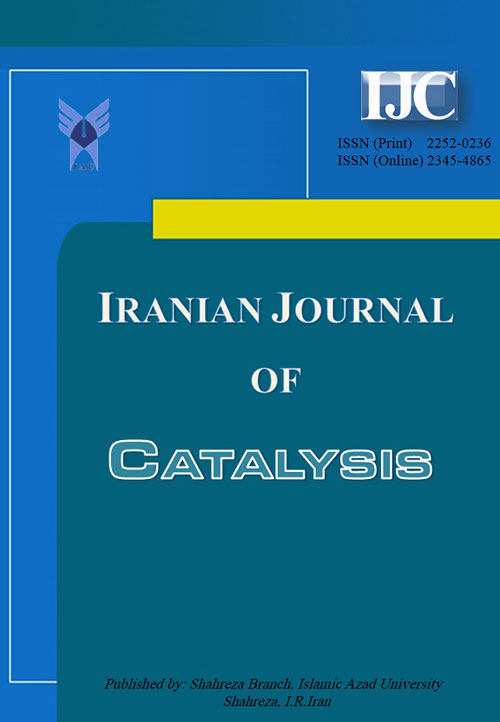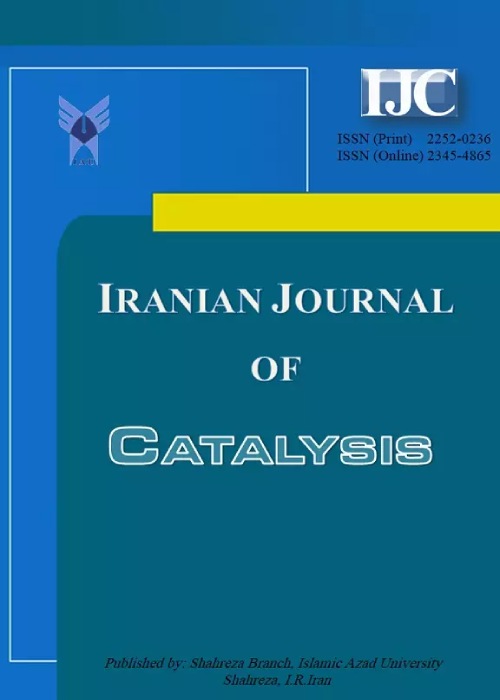فهرست مطالب

Iranian Journal of Catalysis
Volume:8 Issue: 2, Spring 2018
- تاریخ انتشار: 1397/02/11
- تعداد عناوین: 10
-
-
Pages 73-80In this paper, an environmentally benign access to synthesize Bis(pyrazol-5-ol) derivatives was developed through the one pot pseudo five component condensation reaction of phenyl hydrazine with ethyl acetoacetate, and different aryl/heteroaryl aldehydes using morpholinium glycolate as the homogeneous reusable catalyst under solvent-free conditions at 80 °C. Further, the ionic liquid was prepared and characterized by FT-IR, 1HNMR, 13CNMR and TG-DTG techniques. The present synthetic protocol offers excellent yields of the products, short reaction times, clean and simple work up, reusability of catalyst up to five runs, a significant reduction in cost, and eco-efficient alternative to the existing methods.Keywords: Bis(pyrazol-5-ol)s, Morpholinium glycolate, Ionic liquids, Homogeneous catalyst
-
Pages 81-88Kaolin-SO3H nanoparticles were prepared via reaction of kaolin and chlorosulfonic acid and characterized by FT-IR, XRD, FESEM, TEM, XRF, EDS, BET and TGA. The activity of this green catalyst was probed by the synthesis of aryl diazonium salts as the starting reactant and then, their diazo coupling with 2-naphthol to form azo dyes in a solvent-free medium at room temperature. The work-up of the reaction was easy, and the catalyst was removed from the products by simple filtration. The reaction proceeded in a short time, easy purification technique, high yields, and was environmentally friendly furthering approaches to green chemistry. The products were characterized by FT-IR and NMR spectroscopy.Keywords: 2-Naphthol, Kaolin-SO3H, nanoparticles, Diazonium salt, Diazo coupling, Solvent-free
-
Pages 89-94A highly practical and efficient preparation of 3,4-Dihydropyrimidin-2(1H)-one derivatives was developed via an efficient and simple nanocatalyst and promoted multi-component reaction of ethyl acetoacetate, aromatic aldehyde, and urea in the presence of a catalytic amount of (CTA)3[SiW12]-Li+MMT under solvent-free conditions. In comparison to the conventional methods, the salient features of this method are green reaction conditions, short reaction time, high quantitative yields, high atom economy, low cost, no column chromatographic separation and easy isolation of products. All the products were characterized by melting point, IR, 1HNMR and 13CNMR and were determined by comparison of their spectra with those of valid samples.Keywords: Aldehydes, Multi-component reaction, (CTA)3[SiW12]-Li+-MMT, 3, 4-Dihydropyrimidin-2(1H)-one
-
Pages 95-102Magnetically separable MgFe2O4 was synthesized and used in catalytical ozonation of 4-chlorophenol (4-CP). The prepared catalyst was characterized by X-Ray Diffraction (XRD), Field Emission Scanning Electronic Microscopy (FE-SEM), Transmission Electron Microscopy (TEM), Brunauer−Emmett−Teller (BET) and Vibrating-Sample Magnetometer (VSM). The optimum conditions for the highest efficacy of the catalytic ozonation process were found to be pH 7, catalyst dose 0.2 g/L, O3 concentration 1.67 mg/L.min, contact time of 30 min and 4-CP concentration 100 mg/L. At these optimal conditions, the efficiency of process was 93.5%. In addition, the results showed that the catalyst can significantly enhance the mineralization of 4-CP, and more than 70% 4-CP were mineralized in the presence of the catalyst, that is almost 2.5 times higher than ozonation alone. Moreover, the results revealed that the removal efficiency was not affected by solution pH and removal efficiency in the O3/MgFe2O4 process exceeded 90% over a wide pH range of 410. This study demonstrates that MgFe2O4 is a recyclable and efficient catalyst in the ozonation organic pollutants.Keywords: Catalytic ozonation, Mineralization, Magnesium Ferrite, 4-Chlorophenol, Sol-gel
-
Pages 103-111An efficient method for the synthesis of 5-substituted-1H-tetrazoles through the reaction of nitriles with sodium azide using titanium oxidesupported boric acid (TiO2-H3BO3) catalyst was reported. The reactions were carried out at 120 °C and provided the corresponding tetrazoles in good to excellent yields. This method displayed significant advantages such as stability of the catalyst, high product yield, simple methodology, and easy work up. Also, this catalyst can be reused several times without loss of its catalytic activity. The aromatic nitriles with electron-donating and electron-withdrawing groups could be accomplished. The structural characteristics of the catalyst were identified by FT-IR, powder X-ray diffraction (XRD), scanning electron microscopy (SEM), energy-dispersive X-ray spectroscopy (EDX) and inductively coupled plasma (ICP) analyses.Keywords: [3+2] Cycloaddition, Heterogeneous catalyst, 5-Substituted-1H-tetrazoles, Titanium oxide–boric acid, Recyclable
-
Pages 113-120In the present study, Pb-ZnO, Fe-ZnO, Cd-ZnO and Pb-Fe-Cd-ZnO nanoparticles were synthesized by the sonochemical method and those structural and optical properties were investigated by Fourier Transform Infrared spectroscopy (FTIR), UV-Vis spectroscopy, Field Emission Scanning Electron Microscopy (FE-SEM) and X-Ray Diffraction (XRD). Average crystallite size obtained was 60 nm. Moreover, the direct band gap has been calculated using Tauc's approach. Compared with pure ZnO, the band gap of the doped-ZnO NPs is smaller and it depends on the type of dopants. In addition, photocatalytic activity of all samples has been investigated by the degradation of congo red (CR) dye under UV irradiation in an aqueous medium. In the presence of ZnO NPs photocatalytic degradation of 35% was obtained for 180 min. But Pb-ZnO, Fe-ZnO, Cd-ZnO and Pb-Fe-Cd-ZnO have shown the degradation of 45, 57, 65 and 80% respectively; they have the faster decolorization as compared with the ZnO NPs. Moreover, the photocatalyst could be reused for five times without remarkable loss of its activity.Keywords: (Pb, Fe, Cd)-doped ZnO, Sonochemical method, Band gap, Photocatalytic activity
-
Pages 121-132The effect of various parameters (pH, irradiation time, nanophotocatalyst dosages and temperature) on photocatalytic degradation of Direct Red 23 (DR 23) and Direct Brown 166 (DB 166) using pure InVO4 and InVO4-TiO2 nanocomposite were investigated under visible light irradiation. InVO4 and InVO4-TiO2 were synthesized by hydrothermal and sol-gel/ hydrothermal treatment techniques, respectively and characterized by FT-IR spectroscopy, x-ray diffraction (XRD), diffuse reflectance UVvis spectroscopy (DRS), scanning electron microscopy (SEM) and transmission electron microscopy (TEM) images. Doping of TiO2 with InVO4 caused reduction in its band gap value with the resultant improvement in its visible light activity. The efficiency of nanocomposite on azo dyes degradation (pH 7.2, time: 30 min) reached high values (above 95%) under visible light, proving the remarkable photocatalytic activities of obtained composites. Moreover, the results indicated complete mineralization of DR 23 and DB 166 by InVO4- TiO2 under visible light for 300 min.Keywords: Degradation, Mineralization, Azo dye, InVO4, InVO4-TiO2
-
Pages 133-141In the present study, silver-doped TiO2 (Ag/TiO2) nanoparticles were prepared by various Ag doping (wt%) and a combination of sol-gel and ultrasound irradiation. Ag/TiO2 nanoparticles were characterized by energy-dispersive X-ray analysis (EDX), scanning electron microscopy (SEM) and X-ray diffraction (XRD) techniques. Based on the Taguchi method, photocatalytic degradation of (Reactive Blue 255) RB 255 azo dye was examined with Ag/TiO2 nanoparticles under visible light irradiation. Using this method, operation factors such as Ag doping (wt%), pH, mass of catalyst (g) and RB 255 concentration (ppm) were optimized successfully. The results showed that pH, compared to the other factors, plays an important role in the photocatalytic degradation of RB 255 azo dye. The isotherm study Weber-Van Vliet and Fritz-Schlunder (IV) models are the best descriptors of equilibrium behavior. In addition, the kinetic study results indicated that the pseudo first-order has a good agreement with the experimental data.Keywords: Photocatalytic degradation, Ag-TiO2 nanoparticles, Taguchi design, RB 255
-
Pages 143-150Nb2O5 nanoparticles were synthesized by the hydrothermal method. Structural, morphological and elemental analysis of synthesized Nb2O5 nanoparticles was carried out using X-ray diffraction (XRD), scanning electron microscopy (SEM) and energy dispersive X-ray spectroscopy, respectively. The average crystal size calculations were performed on the basis of X-ray diffraction pattern and were about 12.44 nm. The synthesized Nb2O5 nanoparticles were explored for the photocatalytic degradation of congo red (CR) and methylene blue (MB) dyes in their aqueous solutions using a spectrophotometric method. For the Photocatalytic degradation of both the dyes, pH of dye solutions was varied in the range of 2 to 10. For the optimization, the maximum decolorization of 90 % and 87 % was observed for low initial dye concentration of 10 mg/L and pH values of CR and MB dyes were about 8 and 2, respectively. Besides, the effects of parameters such as the contact time and catalyst dose were studied systematically.Keywords: Nb2O5, Hydrothermal method, Congo red, Methylene blue, Degradation, Pseudo first order
-
Pages 151-154Meysam Yarie was born in 1987 in Malayer/ Hamedan, Iran. He received his B.Sc. in Applied Chemistry from Malek-Ashtar University of Technology and M.Sc. in Organic Chemistry from Kurdistan University under the supervision of Dr. Kamal Amani. He received his Ph.D. from Bu-Ali Sina University under the supervision of Professor Mohammad Ali Zolfigol. He is currently working towards his Post-Doctoral under the supervision of Professor Mohammad Ali Zolfigol at Bu-Ali Sina University. His research interest is the design, synthesis and characterization of task-specific biological-based catalysts and their applications in organic synthesis.Keywords: Spotlights, Imidazolium-based salts, Y-aromatic counterions


